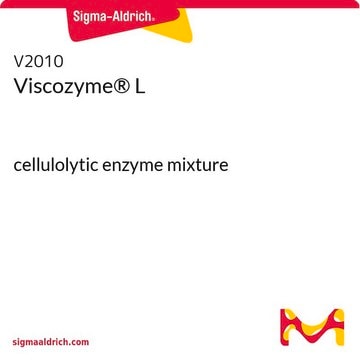C8546
Cellulase from Trichoderma reesei ATCC 26921
lyophilized powder, ≥1 unit/mg solid
Synonym(s):
1,4-(1,3:1,4)-β-D-Glucan 4-glucano-hydrolase
About This Item
Recommended Products
form
lyophilized powder
specific activity
≥1 unit/mg solid
greener alternative product characteristics
Waste Prevention
Design for Energy Efficiency
Learn more about the Principles of Green Chemistry.
sustainability
Greener Alternative Product
solubility
deionized water: soluble 5.0 mg/mL (Sterile; In the presence of 0.15% polyhexamethylene biguanide (PHMB).)
greener alternative category
storage temp.
2-8°C
General description
Application
Biochem/physiol Actions
Unit Definition
Preparation Note
Other Notes
substrate
signalword
Danger
hcodes
Hazard Classifications
Resp. Sens. 1
Storage Class
11 - Combustible Solids
wgk_germany
WGK 1
flash_point_f
Not applicable
flash_point_c
Not applicable
ppe
dust mask type N95 (US), Eyeshields, Faceshields, Gloves
Certificates of Analysis (COA)
Search for Certificates of Analysis (COA) by entering the products Lot/Batch Number. Lot and Batch Numbers can be found on a product’s label following the words ‘Lot’ or ‘Batch’.
Already Own This Product?
Find documentation for the products that you have recently purchased in the Document Library.
Customers Also Viewed
Protocols
To standardize an enzymatic assay procedure of cellulase.
Our team of scientists has experience in all areas of research including Life Science, Material Science, Chemical Synthesis, Chromatography, Analytical and many others.
Contact Technical Service







